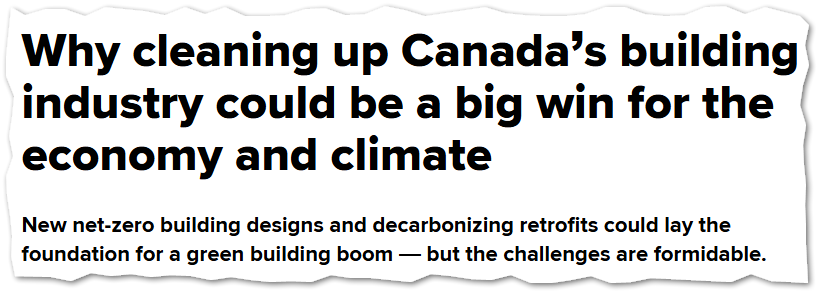When we talk about how much energy our homes in Australia and New Zealand consume, chances are the data underpinning those discussions comes from the Residential Baseline Study (RBS). As highlighted in the recent methodology report for the 2021 update (RBS2.0), this study is a bottom-up engineering, end-use energy model of our residential sectors. Essentially, it builds up a picture …
Canada tackles the massive task of greening its buildings

We often look to other countries for examples and lessons learned in the push towards sustainable buildings. A recent article in Canada’s National Observer (July 2024) highlights the significant challenge and opportunity facing Canada in transforming its building industry to meet net-zero targets by 2050. The built environment, including construction, materials, and operations, accounts for nearly 30% of Canada’s greenhouse …
Mapping residential heat demand and resulting emissions

This is a new paper by Jack et al looking at how residential space heating and hot water varies across New Zealand regions with a focus on the amounts and carbon emissions. The idea is that by knowing where the higher carbon emissions are located and what’s going on we could focus on these higher carbon items first. To do …
Palmerston North’s first Passive House

Heartland city Palmerston North now has its very first certified Passive House project, Hokowhitu Passivhaus. It’s notable for a highly-engaged homeowner, a skilled registered architect and a conscientious building team. None of them had prior experience with Passive House but they did choose a very experienced Passive House designer and altogether it went very smoothly. Read on to admire the …
Replicable design for energy-efficient homes in India

It’s interesting to see how other nations tackle energy efficiency in buildings. The Bureau of Energy Efficiency (BEE)’s Handbook of Replicable Designs for Energy Efficient Residential Buildings in India provides standardised and practical design templates aimed at reducing energy use in Indian homes. It does this by working through Passive House design strategies tuned for Indian climates. The notable difference …
Assessing feasibility of commercial PV generation

EECA recently published guidance for businesses weighing up commercial PV generation. As always, the devil lies in the detail, and understanding the methodology used to assess the viability of solar energy is important for businesses weighing up possible on-site PV generation. The report, Commercial-scale solar in New Zealand: Information for businesses considering investing in solar energy highlights several crucial considerations. …
Tech overview for ECCHO now available

The technical overview for the NZ Green Building Council Energy and Carbon Calculator for Homes is now available. The guide was put together by me and NZGBC’s Sam Archer. It’s a free download, available here, plus there’s general information about the guide here. We developed the first version of ECCHO in Excel using PHPPv9 as the engine, then Sam Archer …
Primary Energy Renewable (PER) is misunderstood

How PHI calculates eligibility for Passive House Plus and Premium certifications seems to be unclear, even to some experienced Passive House designers. There are many factors that impact the amount of energy generated by a specific renewable energy system on a day-to-day basis. But none of that matters for PH Plus or Premium certification. It’s about Primary Energy Renewable. And …
Help coming for PHPP heat pump worksheet
Every Passive House designer who has modelled in PHPP10 knows what a pain it’s become to enter heat pump data. To solve this, we’re developing a heat pump webinar with a whole lot of building physics behind it. (Save the date: 5 March 2025, 12.30 – 2.00pm) PHPP9 allowed standard data to be used, but PHI changed that with the …
